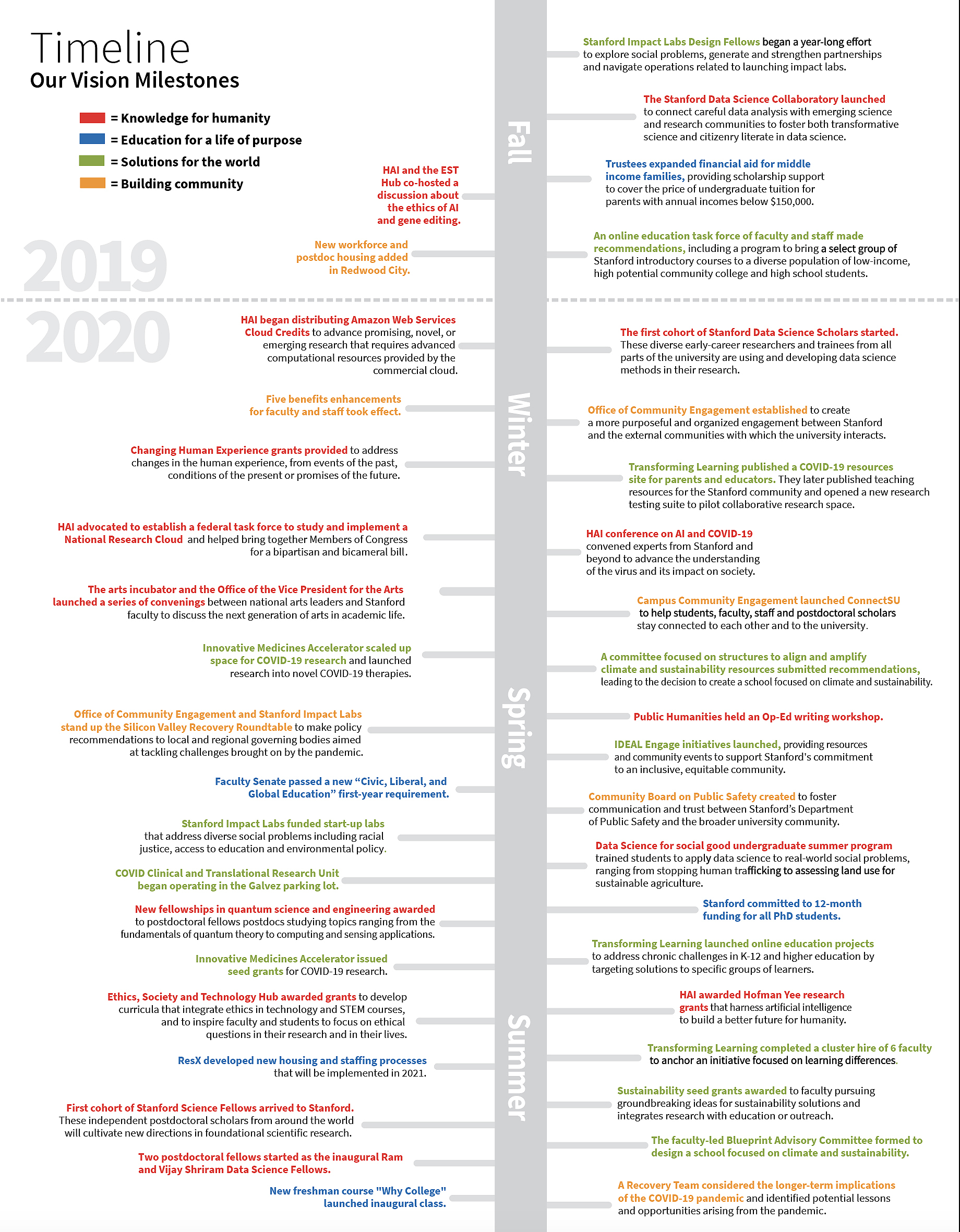Long-Range Vision annual report details activities for 2019-20
In the past year, initiatives associated with the Long-Range Vision created new educational programs, issued seed grants and generated programs to address affordability, among other activities.
New undergraduate courses, support for students in emerging disciplines, a boost for humanities and foundational science scholarship and the launch of initiatives focused on accelerating the development of solutions to societal and health issues are among the outcomes of the Long-Range Vision in the past year, according to an annual report that lays out progress toward the goal of accelerating benefits of the university’s teaching, research and impact in the world.
The 2019-20 LRV Annual Report (SUNet ID required) describes advances that occurred despite disruptions by the pandemic and the urgency of racial injustice, as well as the sudden transition to a mostly online campus community.
“The work that our faculty and staff have accomplished to advance our Long-Range Vision, in spite of COVID-19, is impressive and inspiring and it gives me confidence that we can achieve the ambitious vision we have laid out,” said Stanford President Marc Tessier-Lavigne.
Stanford launched the Long-Range Vision in May 2019 with initiatives focused on the intersecting themes of advancing knowledge for humanity, accelerating solutions for the world and educating students for a life of purpose, in addition to building community.
All of those efforts are true to Stanford’s founding mission of teaching and research for the benefit of humanity and the wider world.
Milestones
The president and provost launched vision initiatives with $100M in one-time funding, resulting in activities that in the 2019-20 academic year enhanced Stanford’s strength in foundational research across disciplines, expanded opportunities for students to engage in new research directions and supported a new model for co-creating solutions with external partners.
Importantly, a focus on climate solutions and sustainability resulted in the decision to create a school that aligns and amplifies existing expertise in research and education. Elements of the school such as departments, educational programs and cross-cutting challenge areas are currently being evaluated by a faculty-led Blueprint Advisory Committee.
In addition, the IDEAL initiative (Inclusion, Diversity, Equity and Access in a Learning Environment) launched IDEAL Engage, providing resources and community events to support Stanford’s commitment to an inclusive, equitable community. In September, Stanford Provost Persis Drell updated the community about additional initiatives aimed at addressing racial injustice, which are already starting to be enacted.
“At Stanford it is incumbent on us, through our research and teaching, to help make significant and profound improvements toward a more just society, and we must ensure that our university is a place where all members of our community are supported and thrive,” said Drell. “Addressing this challenge is important for our country and our university, leading to outcomes that benefit the broadest cross-section of our diverse society.”
Within the theme focused on education, the First-Year Experience initiative was approved by the Faculty Senate in May. In addition, Trustees expanded financial aid for middle-income families by providing scholarship support to cover the price of undergraduate tuition for parents with annual incomes below $150,000, and the provost allocated funding so that PhD students will be eligible to receive 12 months of funding each year, for as long as five years.
Many LRV initiatives fuel the generation of new knowledge across the humanities, sciences, engineering and the arts. One significant step this past year is that the first cohort of Stanford Science Fellows arrived to campus. These independent postdoctoral scholars from around the world are expected to cultivate new directions in foundational scientific research. Similarly, the Changing Human Experience issued grants to humanities and social science researchers exploring new directions in understanding the human experience.
The LRV also supported several new approaches to embedding ethics in innovation through the Ethics, Society & Technology Hub in collaboration with the Stanford Institute for Human-Centered Artificial Intelligence. As one example, they co-sponsored an effort to develop curricula that integrate ethics in technology and STEM courses.
Within the theme focused on accelerating solutions, the Stanford Impact Labs (SIL) began funding start-up labs in the spring. These are part of a novel research and development pipeline for the social sciences, connecting researchers with leaders in the public, social and private sectors to develop evidence-driven solutions to social problems.
The flexible model was proven during the COVID-19 pandemic, when accelerators including SIL, the Innovative Medicines Accelerator and the Transforming Learning Accelerator pivoted to create new partnerships that brought Stanford research to bear on societal, health and educational challenges posed by the pandemic.
“Digital learning has often been treated as creating a menu of online courses. With COVID-19, it became clear that we need to reclaim the learning lost without in-person or residential experiences,” said Dan Schwartz, dean of the Graduate School of Education, who leads the Transforming Learning Accelerator. “This goes beyond academic content to include things like a sense of self, mentoring and shared experiences. Stanford’s initiative in digital learning addresses that loss, and currently five of seven schools have projects.”
The goal of building the Stanford community is also central to the vision, and made progress this year with new programs focused on affordability and additional housing units with priority for postdocs and staff. The Office of Community Engagement also launched with the naming of Megan Swezey Fogarty as associate vice president.
The university is now embarking on a fundraising effort to fuel the vision initiatives in the years ahead and further Stanford’s efforts to bring solutions to the world through its teaching and research.

Initiatives across all Long-Range Vision themes launched activities in the 2019-20 academic year. (Image credit: Dana Granoski)
